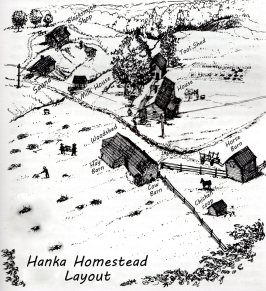
The Axe Story
by Frank Eld
People don't usually get excited about axes, but here is a story some may find intriguing. In the past few days, I have made significant discoveries in the unfolding saga of the Schick Barn Axe. As you know, I'm helping restore the horse barn at the Dry Creek Historical Society farmstead. My involvement began when I selected the Schick Barn as a research project for Dr. Reinhardt's Public History class at BSU.
When I first stepped into the barn two years ago, I was taken aback at the post and beam construction. I study barns and have been in many, but this one was different. The posts and beams were completely oversized! Where most barns would have used 8x8 inch posts up to 24 ft. in length, this had 10x10 inch posts only 12 ft. high. The cross beams were 8x8 inches, again, larger than usual. Also, this massively overbuilt framework had been hand-hewn with a broad-axe! I could not imagine why it was built like this, but I was determined to find out.
The second surprise that day was when I entered the horse section and spotted an unusual broad-axe lying in a stall. This really hooked me on this barn! I became determined to find out who built it, when, and why was it so overbuilt? So I took on the Schick barn as my project.
Research shows that Philip Schick built the barn between 1863, when he filed for a homestead, and 1869, when he was granted the patent. This makes Schick one of Ada County's earliest residents and his barn one of the oldest in the state. When he decided to build his barn, he couldn't build one like his neighbor's, because he didn't have any, so where did he come up with a plan? He patterns his barn after what had known before moving to Idaho. He came from New York State and so he styles it after New York barns. Additional research reveals that early New York barns were built with very heavy post and beam framing, something I confirmed on a recent trip to upstate New York. This explains the beam sizes used by Schick in his barn.
My ongoing research has been the broad-axe and its possible connection with Schick and his barn. My research quickly revealed that the axe is a New England style, used in the mid-19th century, usually for hewing ships' beams. Last year I bought an almost identical one in Massachusetts. Both have a maker's mark but they are nearly illegible, except for a fairly clear Auburn stamp on Schick's axe. This added credibility to my theory that Schick brought this axe when he came from New York. For over a year, I have unsuccessfully searched for a connection of the axe to the Auburn, NY tool makers. No makers' names matched the few letters that were legible. Coincidentally, Robert Ostolasa, who grew up on the farmstead, recently visited the barn and confirmed the axe had been in the barn all his life! Another connection.
A couple of days ago, while searching my library, I came across a long forgotten, Kaufman's Axe Book. In it, I found our axe! It had been made by the Underhill Edge Tool Co in Auburn, New Hampshire. Internet research showed that the Underhill tool company began in NH in the early 1800s, and today the original factory/home of the Underhill’s is the Auburn Historical Society! I contacted their president, Dan Carpenter, and sent him the pictures and the story of our axe. Within a day, he had filled me in on the history of our axe! It was forged by Jesse Johnson Underhill or his son Hazen sometime after 1845. The timeline fits! Coincidentally, Mr. Carpenter says our axe is rare and is only the second one with that mark he has seen. I've now sent him pictures of my axe to see what information he can provide on it.
So, to end, my hypothesis. In the mid-1860s, Philip Schick homesteaded in Dry Creek and as soon as his house is livable, he began building the horse barn. Using horse and wagon, he transported large logs from the hills to his homestead and hand-hewed them into New York style oversized posts and beams, using the broad axe he brought from New England (If he had purchased an axe locally, it would have been a traditional style and not a NE shipwright's axe) By the time he had completed the middle and horse section post and beam framing, his neighbor, Mr. Rossi, also a recent homesteader, had establishes a sawmill and was selling lumber. Schick bought lumber from Rossi (which we know from Rossi's ledger) to finish his roof and siding. Within a few years, Schick adds a cow section to his barn, but instead of hewing the framework, he used Rossi's rough cut lumber, for efficiency. Since the only function of a broad-axe is to hew beams, Schick never used the axe again and just left it in the barn. There it remained for the next 150 years, waiting for someone, who appreciates and understands it, to pick it up and share with you its story!







